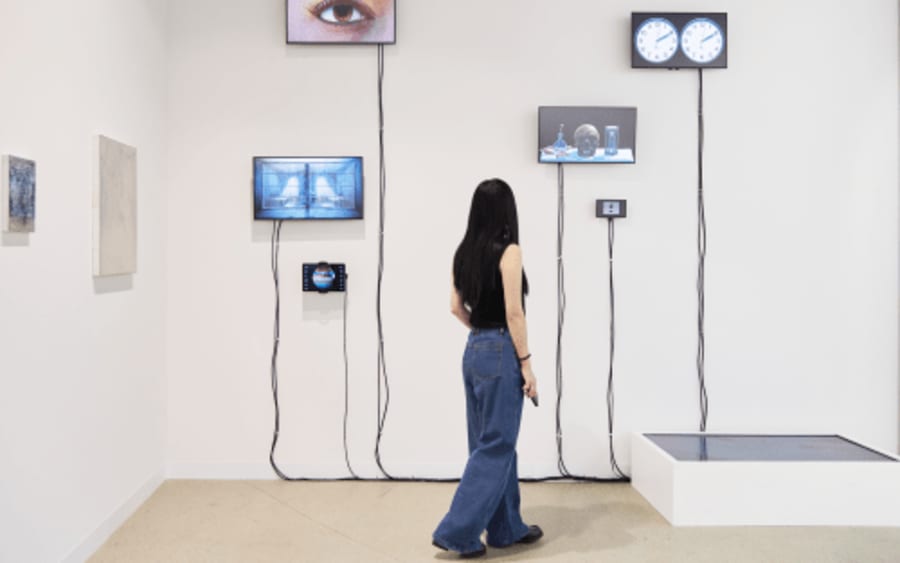The marquee November auctions in New York are a barometer for the high end of the global art market – and last week’s results brought welcome relief for a market that appears to be building momentum after two years in decline. In 2024, the value of auction house sales fell significantly, driven by a 45% drop in the USD 10 million-plus segment, according to the latest Art Basel & UBS Art Market Report. This season, however, brought a change in the weather. Forty works cleared the USD 10 million mark in New York, as sales at Sotheby’s, Christie’s, and Phillips reached USD 2.2 billion, an increase of 70% on last year.
A wave of major private collections of Modern and postwar art brought fresh energy to the market, drawing full houses and fiercely competitive bidding. The standout was the 24-lot, white-glove sale of the late Leonard Lauder’s collection at Sotheby’s, which raised USD 527.5 million and was led by Gustav Klimt’s ethereal Bildnis Elisabeth Lederer (1914–16), which sold for USD 236.4 million – the second-highest price ever paid for a work at auction.
Here are seven takeaways from the fall New York sales.
The Breuer effect
The big names came to the party for Sotheby’s housewarming at 945 Madison Avenue. The Marcel Breuer-designed Brutalist landmark – now the firm’s headquarters – is the former home of the Whitney Museum of American Art, where the cosmetics heir Leonard Lauder served as chairman and bestowed the largest gift in the institution’s history. Perhaps this was a factor in Sotheby’s securing 55 works from Lauder’s collection of 20th-century masterpieces.
A 20-minute contest for the Klimt portrait played out between bidders in the room and on the phones, the tension broken only by applause as the bidding hit USD 200 million and then when the gavel came down to seal a new auction record for a work of Modern art. Two further pieces by Klimt – square-format landscape paintings of the artist’s beloved summer retreat at Attersee – also surpassed pre-sale expectations, with Blumenwiese (c. 1908) selling for USD 86 million and Waldabhang bei Unterach am Attersee (1916) secured for USD 68.3 million by the influential Hong Kong-based art adviser Patti Wong.
A season of single-owner collections
Single-owner collections of 20th-century art dominated the season and accounted for the majority of its value. At Christie’s, the week began with a fine group of 18 works from the little-known collection of the supermarket magnate Robert Weis and his wife, Patricia. The crown jewel of the Weis collection was a classic, 1958 Rothko in autumnal hues, No.31 (Yellow Stripe), which sold for USD 62.2 million to a bidder on the phone. It was joined by Picasso’s portrait of his lover Marie-Thérèse reading – La Lecture (1932) – which sold for USD 45.5 million, as the collection totaled USD 218 million.
On Thursday, Sotheby’s offered 13 works from the collection of Cindy and Jay Pritzker, founders of the Pritzker Architecture Prize and known for their support of civic projects in their native Chicago. The sale was led by a Van Gogh still life of a table strewn with books, Romans parisiens (1887), one of only three paintings by the artist included in the seminal ‘Salon des Indépendants’ exhibition in Paris in 1888. It sold for USD 62.7 million, a record price for a still life by Van Gogh, with the Pritzker evening sale realizing USD 109.5 million overall.
Feeding the omnivores
This year’s Art Basel & UBS Survey of Global Collecting found that the younger high-net-worth individuals are omnivore collectors – as active in fine art as they are in luxury and collectible categories. Phillips may have had this in mind when it offered a juvenile triceratops skeleton named CERA as lot six of its evening sale of Modern and contemporary art. The strategy worked, with the 66-million-year-old skeleton from the Late Cretaceous period selling above estimate for USD 5.4 million. ‘It is undeniable that today’s global collectors are increasingly drawn to rare and extraordinary objects that transcend traditional collecting categories. They seek the unexpected,’ Phillips’s Miety Heiden said ahead of the sale.
Frida and the female Surrealists
The market for Surrealism, which has thrived in a more cautious market overall, showed its strength again last week. Sotheby’s presented Exquisite Corpus, an impressive private collection of Surrealist art, reportedly that of the late record label executive Nesuhi Ertegun and his wife Selma. The star lot was Frida Kahlo’s poignant meditation on life and death, El sueño (La cama) (1940), in which she depicted herself lying on a bed, entwined with curling green vines, while a skeleton wired with dynamite rests on the canopy above. (Kahlo did in fact keep a papier-mâché skeleton above her bed.) The painting, which had sold at Sotheby’s in 1980 for just USD 51,000, exceeded expectations to sell for USD 54.7 million, an auction record for a female artist.
There were records for other Surrealist women, too, including Dorothea Tanning, whose Interior with Sudden Joy (1951) sold for USD 3.2 million in the same sale as the Kahlo, and Leonor Fini, whose Dans la tour (Autoportrait avec Constantin Jeleński) (1952) had sold for USD 2.5 million earlier in the week at Christie’s.
Records but women artists still trail at the top
The latest Survey of Global Collecting published by Art Basel and UBS found that high-net-worth individuals’ collections remain skewed toward male artists, with works by women accounting for 44% of the pieces they own (up from 33% in 2018). Even with the strong results for female Surrealists, and records for artists including the Colombian textile artist Olga de Amaral and the British painter Cecily Brown, women accounted for only about 15% of the lots on offer and 9% of the total value across the marquee evening sales at Sotheby’s, Christie’s, and Phillips. At the very top of the market, there is still considerable ground to make up.
Twentieth-century boys
Modern and postwar masters set the pace at the top of the market last week. Of the 10 most expensive works sold in New York, only one came in a contemporary sale: Jean-Michel Basquiat’s canvas Crowns (Peso Neto) – painted on Christmas Day 1981, a few days after his 21st birthday – which sold for USD 48.3 million at Sotheby’s. The top price for a work by a living artist was for David Hockney’s vibrant 1968 double portrait of Christopher Isherwood and Don Bachardy, showing the pair in a sunlit Santa Monica living room, which sold for USD 44.3 million in Christie’s 20th Century Evening Sale.
Flushed with success
With collectors gravitating toward 20th-century masters, contemporary departments have been getting creative to hold the spotlight. At Sotheby’s this took the form of a fully functioning 18-karat solid-gold toilet: Maurizio Cattelan’s America. First installed at the Guggenheim in 2016 – where visitors queued for ‘unprecedented intimacy with a work of art,’ in the museum’s words – the piece gained further notoriety when it was stolen in a heist during an exhibition at Blenheim Palace in the English countryside three years later. The only surviving edition – reportedly consigned by the hedge-fund manager Steve Cohen – was offered with a starting bid determined by the spot price of the work’s weight in gold (about USD 10 million). On the night, it was worth its weight in gold – just – hammering on the first bid to sell for USD 12.1 million with fees. The buyer was the US museum of oddities Ripley’s Believe It or Not!.
Download The Art Basel and UBS Survey of Global Collecting 2025 here.
Toby Skeggs is a writer and editor specializing in the art market.
Caption for header image: Auctioneer Oliver Barker. Photo: Julian Cassady Photography / Courtesy of Sotheby’s.
Published on November 25, 2025.


